Safari Club International Blue Bag Program
SafariCare Blue Bag from the Calgary Chapter of Safari Club International (SCI).
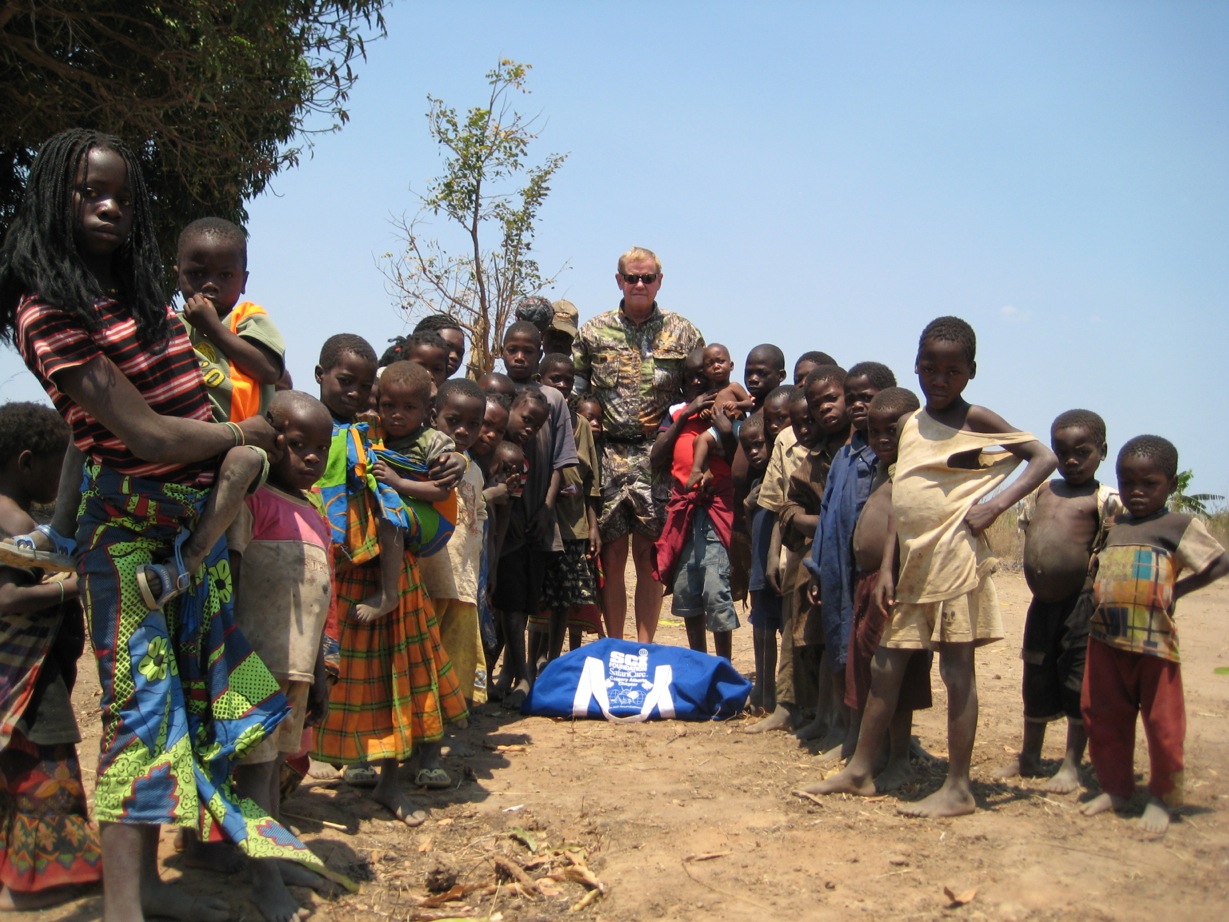 In 1996, SCI Members delivered mosquito nets and other medical supplies to villagers in remote areas of Namibia. That was the inaugural step of SafariCare. The idea behind SafariCare is to use the transportation services of hunters to get supplies to hard-to-reach places around the world. SCI and the SCI Foundation expend an enormous effort each year getting school supplies, sports equipment, and other items to needy people. I had always admired this spirit of charity, and wanted do my part.
In 1996, SCI Members delivered mosquito nets and other medical supplies to villagers in remote areas of Namibia. That was the inaugural step of SafariCare. The idea behind SafariCare is to use the transportation services of hunters to get supplies to hard-to-reach places around the world. SCI and the SCI Foundation expend an enormous effort each year getting school supplies, sports equipment, and other items to needy people. I had always admired this spirit of charity, and wanted do my part.
Natalie Nesbitt, on behalf of the Calgary Chapter, donated six soccer balls, two air pumps, and a number of air needles. I serve on the board of the Glencoe Club, a Calgary family and sports club, and talked to them about my expedition. Our fitness program came together to donate forty-four surplus long-sleeved T-shirts in small or extra-small sizes, which were left over from a road race earlier in the year. I had learned from previous trips to Africa that medium, large and XL shirts are not suited to the locals’ stature. Eve, my twelve-year-old next-door neighbor, heard about the project. She wanted to be involved as well (giving is contagious!), so she donated school supplies and stuffed animals to the Blue Bag.
Matimbo Safaris’ concession lies in the heart of northern Mozambique. From Pemba, it took us most of a day to get to the camp in Guy’s Land Cruiser. Along the way, we passed a number of impressive “water points” in villages. They are constructed of stainless steel on concrete pads. The crowds around the pumps would seem to indicate that they are a huge success. However, I soon learned the water points are not all beneficial, because they cause populations to cluster along the roadway. When the poor soils can no longer sustain the village, the local population does not move to more fertile soils as they would normally. They are tied to the source of fresh water—the donated water point—but are unable to grow much food. They then become dependent upon the government for food.
Mozambique is one of the poorest countries in the world. Unlike the British in Kenya and Tanzania, the Portuguese colonizers had little appetite for building up the local economy and infrastructure, and essentially looted the country for raw materials and labor. The war for independence lasted from 1961 to 1974, and devastated the country. Once the Portuguese had been kicked out, an internal struggle for power began. The Mozambican civil war only ended in 1992. Since then, the country has been relatively peaceful, but the wounds of war take a long time to heal. In the past decade, economic growth has been substantial—around 8 percent per year—but they are starting from next to nothing.
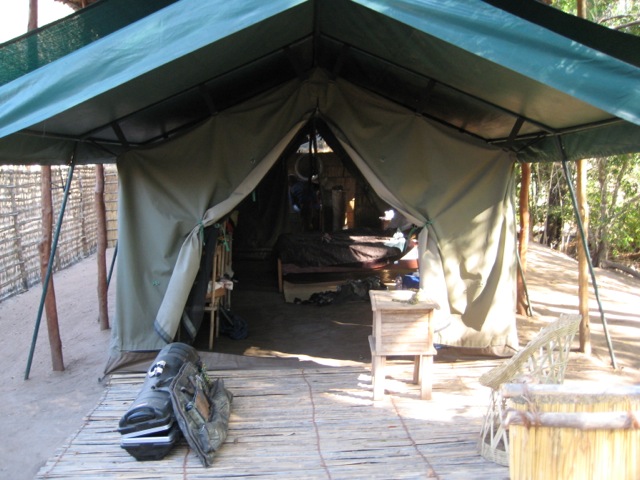 We reached the camp in the afternoon, and I was happy to settle in to my comfortably furnished twelve- by twenty-foot tent with its en suite bathroom and shower. The tents were erected under large thatched structures to keep them cool in the midday sun.
We reached the camp in the afternoon, and I was happy to settle in to my comfortably furnished twelve- by twenty-foot tent with its en suite bathroom and shower. The tents were erected under large thatched structures to keep them cool in the midday sun.
One of the guests in the camp was a Swiss development officer named Anna. She worked with an NGO in Mozambique. That evening, we got into a good discussion about aid versus development. These types of discussions seldom solve anything, but it is always interesting to hear different points of view. Ironically, her NGO is sponsored by the government of Switzerland (making a mockery of the “N” in the acronym!). The international community, Anna told me, is moving away from simple, direct, old-fashioned “aid,” and toward “development.” The NGOs are eager to see something grow out of their giving through partnerships, investments and integration with the local government. There is a new effort to measure the effectiveness of their development programs, because donors are now demanding proof that their money is doing some lasting good.
On the first day of hunting, we had a spot of bad luck: we ran over a black mamba on the track. The black mamba is the world’s fastest snake and, though he wrenched the steering wheel wildly, Guy was unable to avoid it. This bad omen was to overshadow our luck for the first week and a half. Though I had several chances to shoot leopards and other game, I missed them all.
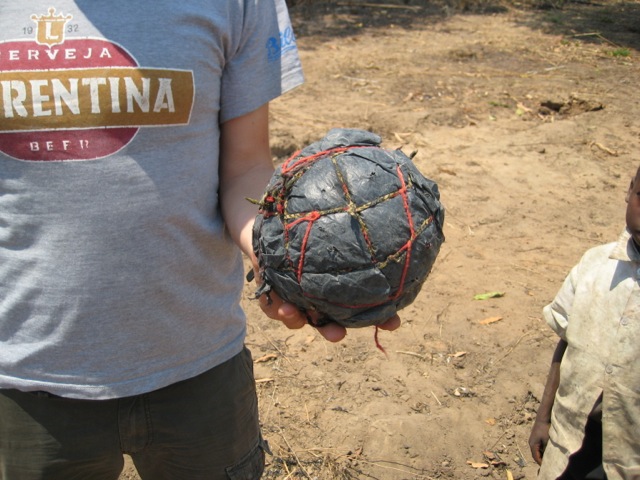 On the eighth afternoon of the hunt, we drove to the closest village to give out some soccer balls. The playground was a bare patch of ground. The ubiquitous thorns had been cleared, allowing the players to play barefoot. As soon as we stopped, a crowd of children appeared out of nowhere. They showed me their homemade soccer ball. It was constructed of wadded scraps of plastic bags bound with twine. The air bladder of the ball was a condom (an unintended consequence of an aid program!). The children were thrilled to receive a real, full-size soccer ball, even though their idea of soccer seemed to be to kick the ball as high as possible. I also gave away a few smaller balls for the little ones to kick and chase around. We left an air pump in the care of a village elder who had fifteen children: enough to start his own team! It was wonderful to see the joy a few simple gifts could bring, and I told myself that the trip was worthwhile just to see the smiles on the faces of the kids, even if I didn’t bag a cat.
On the eighth afternoon of the hunt, we drove to the closest village to give out some soccer balls. The playground was a bare patch of ground. The ubiquitous thorns had been cleared, allowing the players to play barefoot. As soon as we stopped, a crowd of children appeared out of nowhere. They showed me their homemade soccer ball. It was constructed of wadded scraps of plastic bags bound with twine. The air bladder of the ball was a condom (an unintended consequence of an aid program!). The children were thrilled to receive a real, full-size soccer ball, even though their idea of soccer seemed to be to kick the ball as high as possible. I also gave away a few smaller balls for the little ones to kick and chase around. We left an air pump in the care of a village elder who had fifteen children: enough to start his own team! It was wonderful to see the joy a few simple gifts could bring, and I told myself that the trip was worthwhile just to see the smiles on the faces of the kids, even if I didn’t bag a cat.
Nevertheless, I was worried about our bad luck, and asked Guy if we could ask the locals to make an offering to their gods. We had done this the previous year in the swamps of the Zambezi, and had enjoyed immediate success. Guy agreed, saying that he had been meaning to call the chiefs together for a jointy-jointy: a ceremony for their gods.
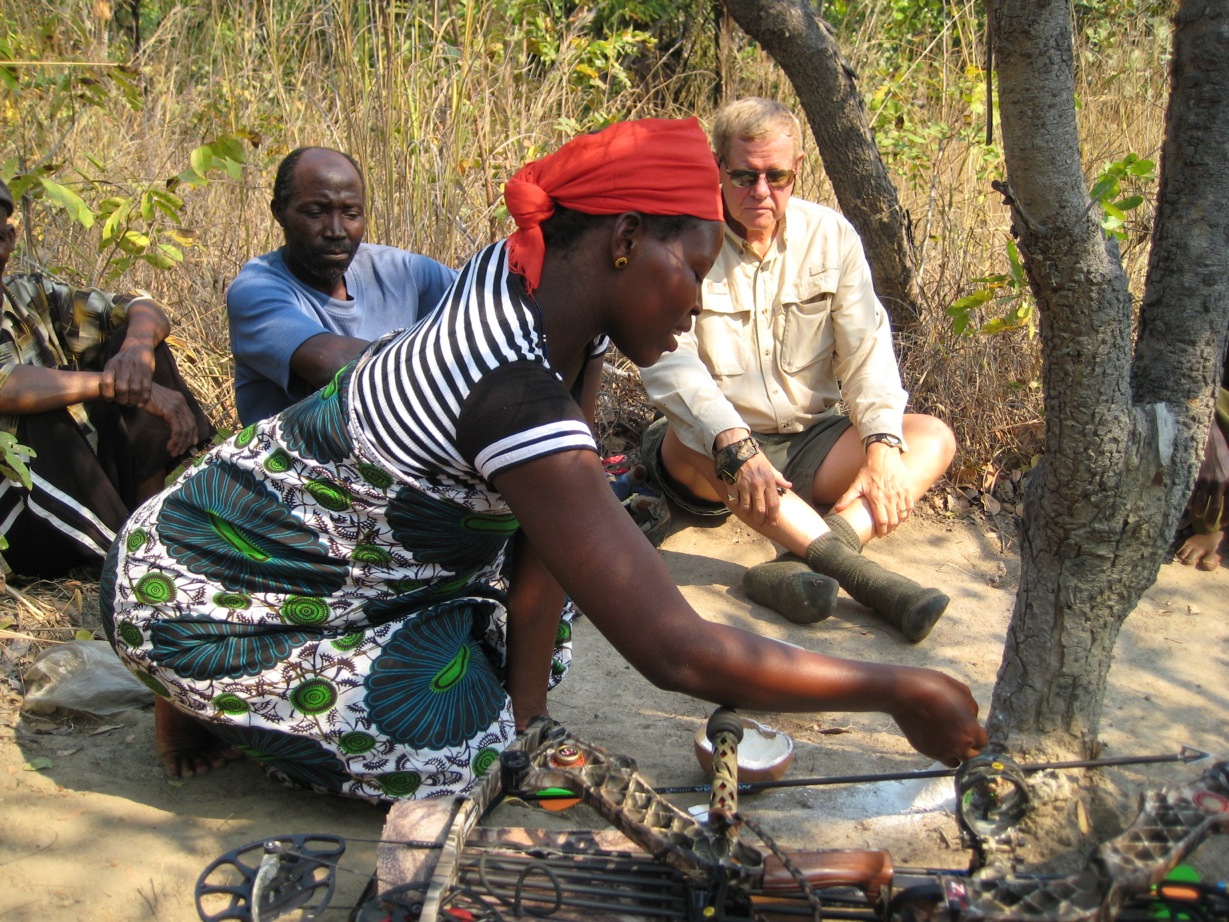 We held the jointy-jointy at noon on the last Sunday. My bow and arrows were placed against a sacred tree and anointed, and the locals, including three chiefs and a queen, gave speeches.
We held the jointy-jointy at noon on the last Sunday. My bow and arrows were placed against a sacred tree and anointed, and the locals, including three chiefs and a queen, gave speeches.
Immediately after the ceremony, we hurried to the soccer pitch in the center of the village. A soccer match between the Matimbo Safaris staff and the local village boys was set for two p.m. This was a rematch of a game earlier in the season in which the staff had defeated the villagers one–nil. That game had been called because the ball got a puncture. Today’s game, we hoped, would be a bigger success, because we were bringing the SafariCare bag full of soccer balls, pumps, and uniforms.
When we arrived at the soccer pitch, there was already a crowd of several hundred. The home team was huddled around the chief (who was also the coach), trying to inflate their ball. The ball still had a hole, so their efforts were fruitless. They were delighted when I presented them with a brand new game ball, and began singing their thanks.
[youtube http://www.youtube.com/watch?v=yeMzu0O2bh0]
The chief began his coaching duties in earnest now, drawing plays in the dust. I reached into the Blue Bag, brought out the long-sleeved white T-shirts, and began distributing them. However, since I couldn’t tell the players from the onlookers, the shirts were starting to fall into the wrong hands. These people are traders, so a “secondary market” in T-shirts instantly opened in the grass behind the crowd. Some guys were trading the shirts for a few meticals, for a drink, or for whatever else the customer could offer. The chief quickly put a stop to that, rounding up all the extra shirts and saving them for his players. I gave him an air pump, a few air needles, and several more balls for his inventory. I hoped this would keep them going for a year or so.
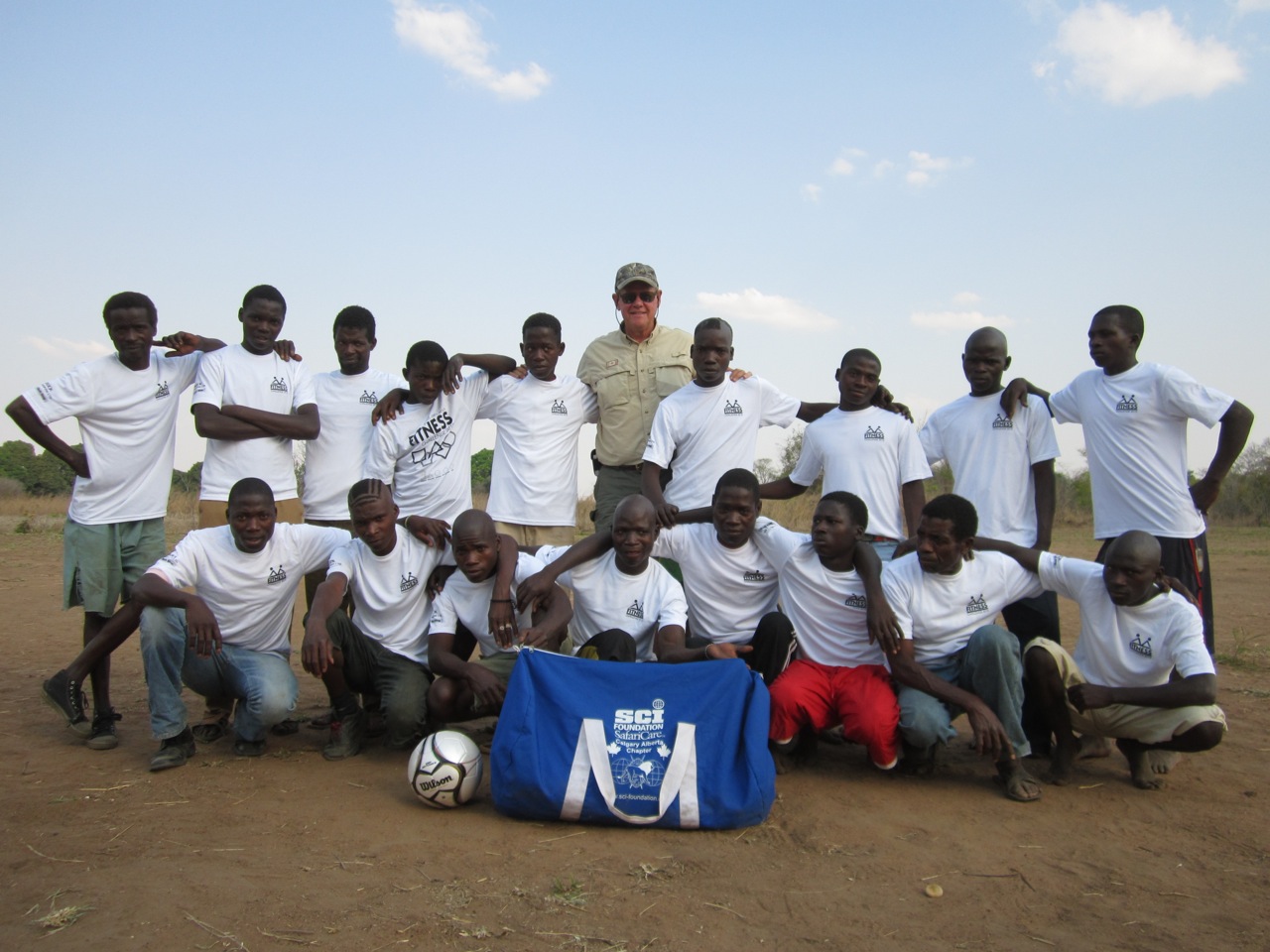 The players pulled on their shirts, and immediately looked much more like a team . . . even if one shirt was on backward! As the teams warmed up, I gave the school supplies to the local teacher. This was Sunday, so the kids were not in class. The teacher beamed and said he would distribute the supplies the next day.
The players pulled on their shirts, and immediately looked much more like a team . . . even if one shirt was on backward! As the teams warmed up, I gave the school supplies to the local teacher. This was Sunday, so the kids were not in class. The teacher beamed and said he would distribute the supplies the next day.
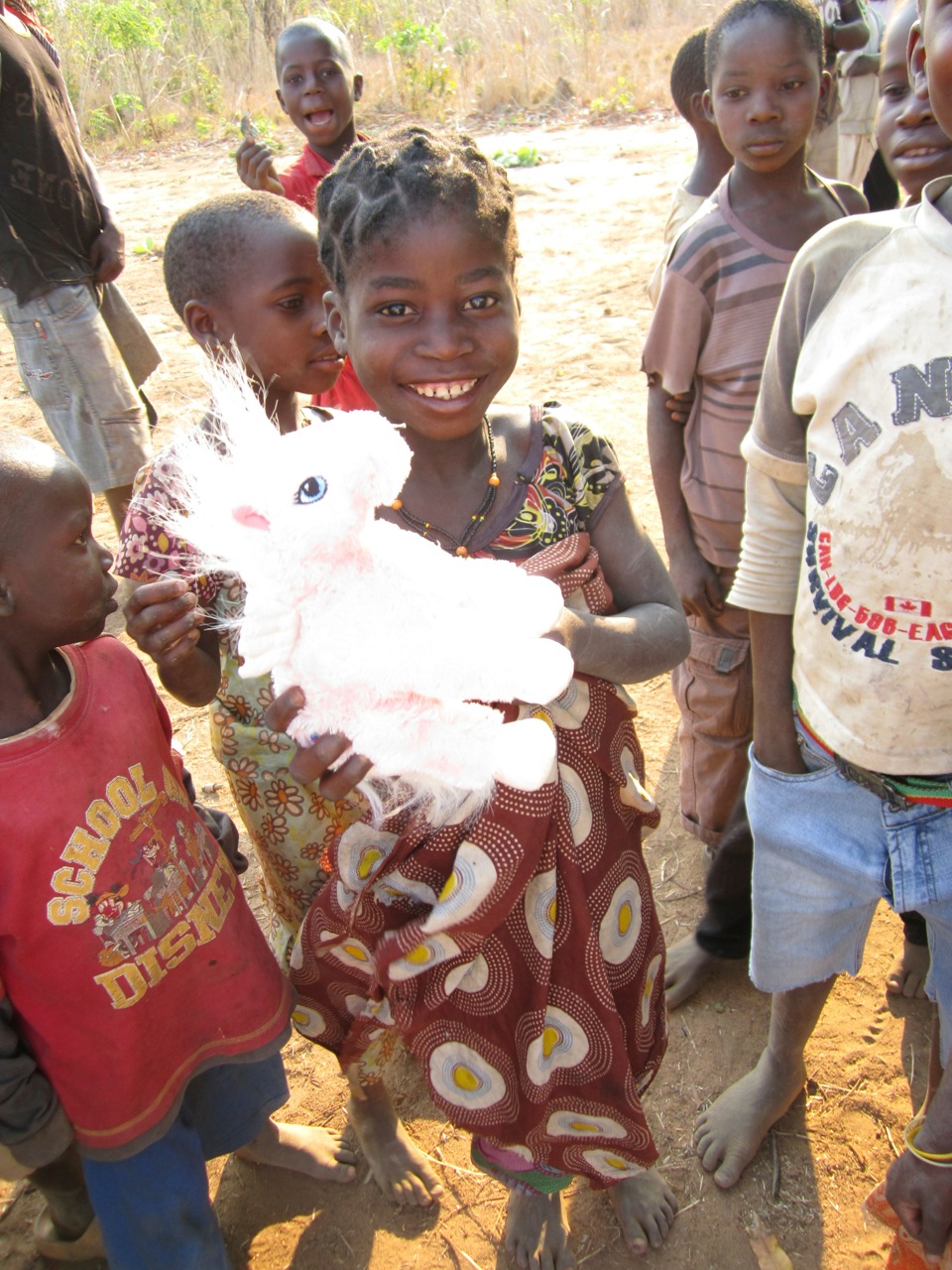 The soccer equipment and school supplies handed out, I turned to the toys. I started passing out stuffed animals to the smaller children, but was soon mobbed. There were more children than toys and they began to crush around me, delighted but a bit frantic. I soon ran out of stuffies, but luckily I had a bag of seventy-eight small plastic animals. I opened it and began hurling animals in all directions. The kids scattered, chasing each handful and it became a big cheerful game. Five minutes later, the bag was empty.
The soccer equipment and school supplies handed out, I turned to the toys. I started passing out stuffed animals to the smaller children, but was soon mobbed. There were more children than toys and they began to crush around me, delighted but a bit frantic. I soon ran out of stuffies, but luckily I had a bag of seventy-eight small plastic animals. I opened it and began hurling animals in all directions. The kids scattered, chasing each handful and it became a big cheerful game. Five minutes later, the bag was empty.
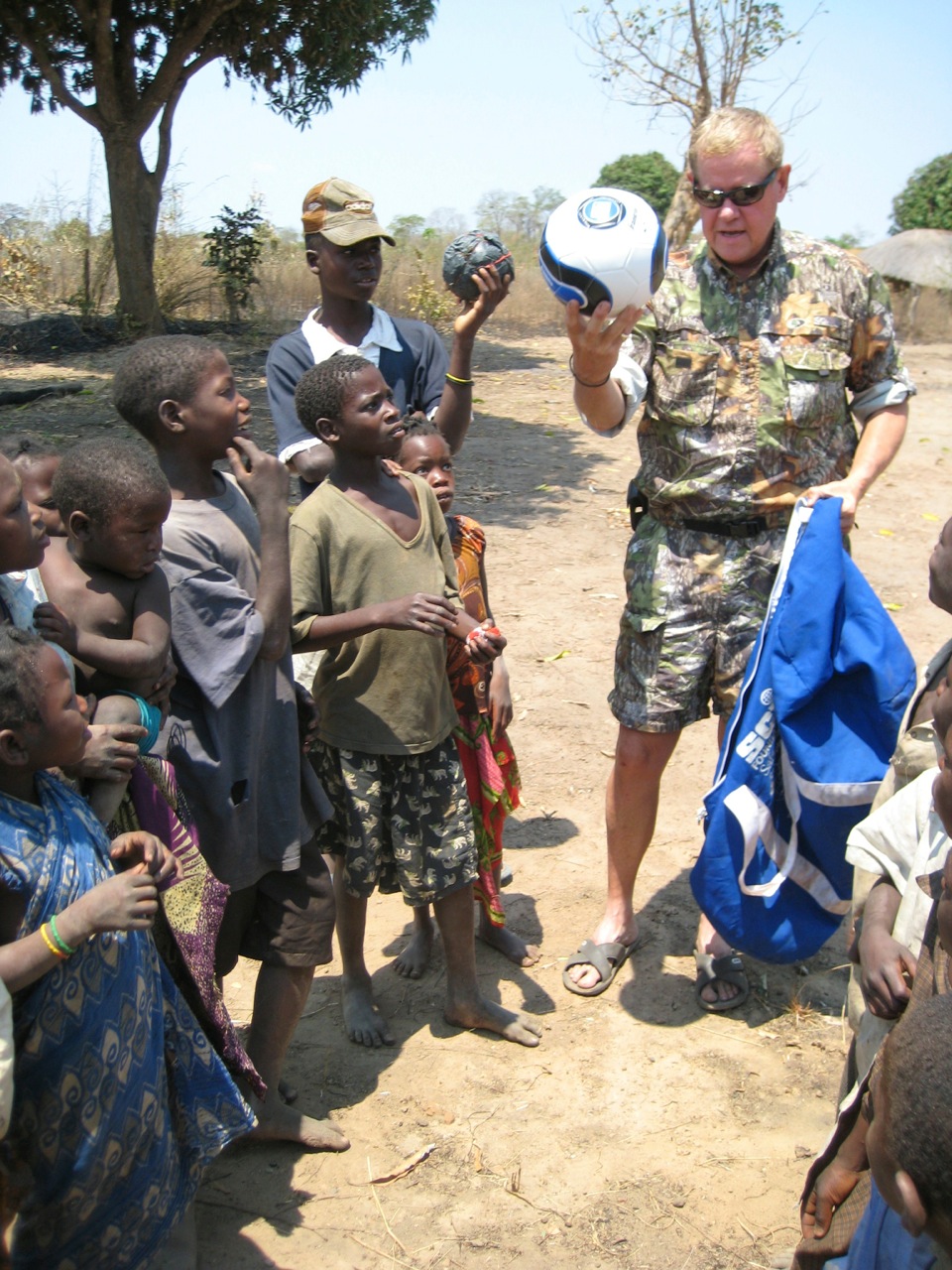 This wasn’t aid, charity, or development . . . it was simply a fun-filled field day for a poor village in Africa. I think the Blue Bag was an unqualified success!
This wasn’t aid, charity, or development . . . it was simply a fun-filled field day for a poor village in Africa. I think the Blue Bag was an unqualified success!
Guy is a veteran rugby player, and had captained Zimbabwe’s cricket team at the turn of the century. He led his Matimbo Safaris team in performing the haka, the war dance of the Maoris of New Zealand, which the All Blacks use to terrify their opponents. As Guy and his coworkers chanted and stomped toward the opposing team, the village players began to look alarmed, but they collapsed in giggles as soon as the last shout evaporated in the dusty air.
[youtube http://www.youtube.com/watch?v=tJOdh-LkiEs]
We left before the game was over because Guy and I wanted to be in the blind well before dark and it was a couple hours’ drive away, at the eastern end of the concession. That evening, we set up a blind less than thirty yards from a leopard bait in a tree over a waterhole. But I did not get a leopard that night. I got something much bigger.
As Guy and I sat in attentive silence that night, we heard a rustle from the direction of the waterhole. A few moments later, an enormous beast crashed through the underbrush and moved by the tent tossing its head. It was so massive that it reminded me of a bull entering a ring. I thought it was an eland, but Guy murmured that it was a lion. The lion turned and approached the tent. When it was fifteen yards away, Guy switched on the flashlight, and I shot. We tracked the wounded lion for an hour or so that night, until it backtracked once too often. Tracking a wounded lion at night is dangerous, so Guy made the decision to head back to the camp.
The next morning, we resumed our tracking, following the blood spoor. After an hour or so, we came across the dead lion on the far side of a clearing. As we drove into the camp, the blacks began singing and dancing, and one of the chiefs insisted on giving me a piggyback ride!
![DSC00326[5]](https://safariclub.org/wp-content/uploads/2020/05/dsc003265.jpeg) I had experienced in the couple weeks at the camp an incredible range of emotions: the joy of seeing destitute kids made happy by a few simple gifts, the disappointment of missing several shots, the mystery of a traditional ceremony, and the thrill of encountering and shooting a lion in the African wild. It was an astonishing experience, enriched by the SafariCare Blue Bag program. Without the Blue Bag, I wouldn‚Äôt have seen the delight in the children‚Äôs eyes or the pride of a village soccer team wearing new uniforms. I cherish those memories along with the memory of shooting my first wild lion.–David Avery Little
I had experienced in the couple weeks at the camp an incredible range of emotions: the joy of seeing destitute kids made happy by a few simple gifts, the disappointment of missing several shots, the mystery of a traditional ceremony, and the thrill of encountering and shooting a lion in the African wild. It was an astonishing experience, enriched by the SafariCare Blue Bag program. Without the Blue Bag, I wouldn‚Äôt have seen the delight in the children‚Äôs eyes or the pride of a village soccer team wearing new uniforms. I cherish those memories along with the memory of shooting my first wild lion.–David Avery Little
[youtube http://www.youtube.com/watch?v=eGvje7HLCqA&w=420&h=315]

